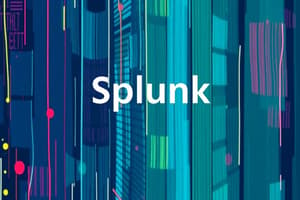Podcast
Questions and Answers
What is one of the key areas that Splunk focuses on?
What is one of the key areas that Splunk focuses on?
- Graphic design
- Social media marketing
- Software development
- Data analysis (correct)
How does Splunk enable data analysis?
How does Splunk enable data analysis?
- By consolidating data from applications only
- By handling IoT sensors but not network devices
- By analyzing data from log files using pattern recognition (correct)
- By collecting data from databases only
What advanced analytics capabilities does Splunk use for data interpretation?
What advanced analytics capabilities does Splunk use for data interpretation?
- Traffic analysis algorithms
- Machine learning algorithms (correct)
- Basic arithmetic operations
- Data encryption techniques
What feature in Splunk allows users to easily find and analyze data patterns?
What feature in Splunk allows users to easily find and analyze data patterns?
How do reports in Splunk help stakeholders?
How do reports in Splunk help stakeholders?
What is the main benefit organizations can derive from leveraging Splunk?
What is the main benefit organizations can derive from leveraging Splunk?
What is one of the key benefits of Splunk's log management feature?
What is one of the key benefits of Splunk's log management feature?
Which feature of Splunk helps organizations detect anomalies and errors in their data?
Which feature of Splunk helps organizations detect anomalies and errors in their data?
How does Splunk assist IT teams in maintaining a secure data infrastructure?
How does Splunk assist IT teams in maintaining a secure data infrastructure?
Which aspect of Splunk's functionality helps in resolving data issues more quickly?
Which aspect of Splunk's functionality helps in resolving data issues more quickly?
What is one of the main purposes of Splunk's data visualization capabilities?
What is one of the main purposes of Splunk's data visualization capabilities?
Which feature of Splunk is particularly useful for creating reports based on analyzed log data?
Which feature of Splunk is particularly useful for creating reports based on analyzed log data?
Flashcards are hidden until you start studying
Study Notes
Splunk is a powerful data analysis platform that offers various features for managing, monitoring, and making sense of large data sets. The platform focuses on key areas such as data collection, analysis, monitoring, alerting, reporting, and data visualization. By leveraging Splunk, organizations can improve their data infrastructure, optimize performance, and enhance their ability to derive insights from complex data sets.
Data Analysis
Splunk enables data analysis by collecting, consolidating, and analyzing data from various sources, including databases, applications, servers, network devices, log files, APIs, and IoT sensors. It uses advanced analytics capabilities, such as statistical analysis, machine learning algorithms, and pattern recognition, to process and interpret the collected data efficiently. This allows organizations to gain valuable insights from their data, which can be used to drive business decisions, optimize processes, and improve overall performance.
Search and Reporting
Splunk offers powerful search capabilities that allow users to easily find and analyze data patterns within their datasets. The platform also provides reporting features, including dashboards, charts, graphs, and summary statistics, which help stakeholders understand the current state of their data and identify trends. These reports can be customized to meet specific needs, providing valuable insights that can inform decision-making processes.
Log Management
Splunk excels in log management, consolidating and analyzing log data from various sources to provide a comprehensive view of an organization's IT infrastructure. This enables IT teams to monitor system performance, identify issues, and ensure compliance with predefined business rules. By analyzing log data in real-time or near real-time, Splunk helps organizations maintain a robust and secure data infrastructure.
Monitoring and Alerting
Splunk's monitoring and alerting features enable organizations to detect anomalies, errors, and patterns in their data. The platform can generate alerts or notifications when an issue or abnormality is detected, ensuring that responsible individuals are promptly informed about data anomalies that require attention. This proactive approach to monitoring helps teams resolve issues more quickly, minimizing downtime and reducing the risk of data loss.
Data Visualization
Splunk's data visualization capabilities allow users to create graphs, charts, and other visual representations of their data. These visualizations help stakeholders understand complex data sets and identify trends, patterns, and correlations that may not be apparent through raw data analysis. Splunk's visualization tools can be integrated with other platforms, such as Hadoop, to provide a comprehensive view of an organization's data landscape.
In summary, Splunk is a versatile platform that offers a range of features for managing, analyzing, and deriving insights from large data sets. By focusing on key areas such as data analysis, search and reporting, log management, monitoring and alerting, and data visualization, Splunk helps organizations optimize their data infrastructure, improve performance, and make informed decisions.
Studying That Suits You
Use AI to generate personalized quizzes and flashcards to suit your learning preferences.




